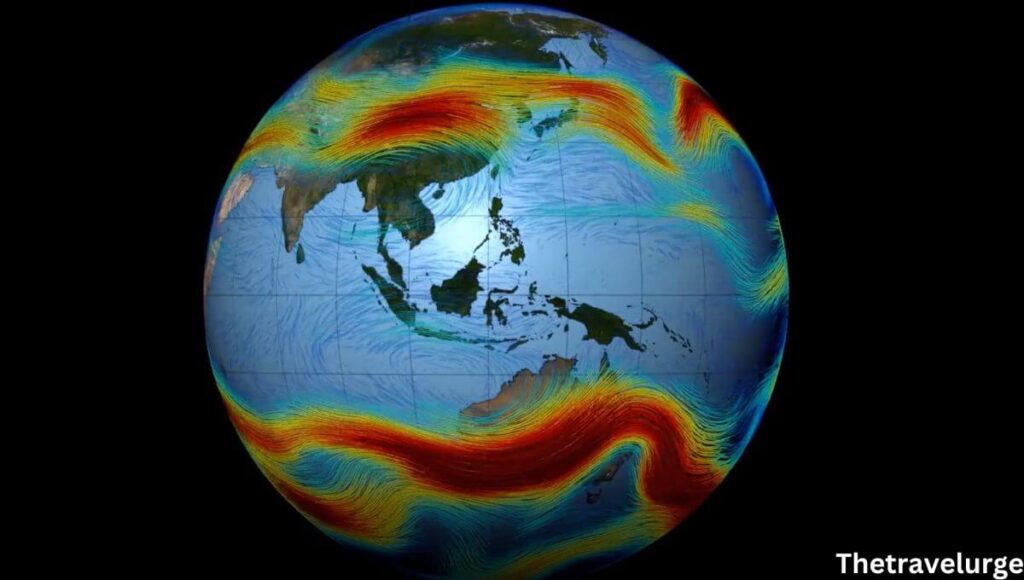The jet stream, a high-speed air current high in the Earth’s atmosphere, plays a pivotal role in shaping our weather patterns. This jet stream isn’t an ordinary wind. It’s like nature’s highway. Directing storms and impacting temperatures worldwide. Its swift movement impacts everything from our daily weather forecasts to larger climate patterns, making it a fascinating subject to explore. Let’s delve into the secrets behind this atmospheric phenomenon and uncover how it shapes the world around us.
Jet stream creating some unusual flight patterns
Flights from the East Coast to the West Coast aren’t the only ones facing extended durations because of the jet stream. Interestingly, flights heading eastward are becoming shorter because they receive a favorable push from this high-speed air current. In fact, there’s been an increase in several flights taking less than six hours to reach Europe. Moreover, flights departing from the U.S. West Coast to the East Coast benefit from a significant boost from the jet stream, occasionally resulting in earlier-than-expected arrivals.
The jet stream’s incredible force over the Atlantic Ocean is propelling airplanes at speeds roughly 200 miles per hour faster than their usual pace. Consequently, certain flights originating from New York and bound for London are soaring at an impressive 778 miles per hour, significantly surpassing the typical average flight speed of around 550 miles per hour.
For instance, American Airlines Flight 106 departed from New York’s John F. Kennedy International Airport (JFK) bound for London’s Heathrow Airport (LHR) and completed its journey in an astonishingly short time of five hours and 52 minutes on a recent Tuesday. Even more remarkably, on October 31. The same flight managed to cover the distance in just five and a half hours. This starkly contrasts with the usual average flight duration for this route, which typically spans around six hours and 13 minutes.
Presently quicker than East Coast to West Coast flights, but nowhere near the fastest. A British Airways flight covered the journey from New York to London in just four hours and 56 minutes back in February 2020.
What is the jet stream?
High above the Earth’s surface, the jet stream comprises powerful winds that predominantly flow from west to east. Aircraft entering the jet stream can benefit from its push or encounter resistance against it. Consequently, flights heading eastward typically enjoy faster travel times compared to those heading west. At around 30,000 feet above the Earth, pilots frequently target this high-altitude wind pathway. Known as the jet stream, once they’ve attained their “cruising altitude.”
Variations in temperatures can either accelerate or decelerate the winds within the jet stream. The National Oceanic and Atmospheric Administration states that these temperature differences. Most notably evident in winter, this leads to the jet streams being most robust during both the northern and southern hemisphere winters.
As per meteorologist Sam Champion from “Good Morning America” and WABC-TV. et streams tend to be more robust during transitions between cold and hot seasons or vice versa.
Champion emphasized, “Those extreme temperature changes significantly influence the jet stream.” He further explained that the current positioning of the jet stream aligns with the flight paths from the U.S. to England. This alignment is precisely why people are experiencing these exceptionally fast flight times.
The Importance of Paying Attention to the Jet Stream
Arriving at your destination earlier than expected is generally seen as a positive occurrence, yet it may not guarantee a completely smooth experience. At times, if there’s no available gate, you might end up waiting on the ground upon arrival. Airlines generally prefer to adhere closely to their schedules.
Furthermore, arriving late, as I encountered on Tuesday night, can result in substantial problems. For instance, if I had been rushing to catch an early morning international flight in another terminal at San Francisco International Airport (SFO), it could have posed a real challenge.
“Airlines can’t control the weather,” mentioned Henry Harteveldt, a travel industry analyst and president of Atmosphere Research. However, he emphasized that airlines have a responsibility to adapt their schedules for consumers.
“The jet stream has been around for some time,” remarked Harteveldt. “The changes occur in wind speeds… the routes are more varied due to climate change,” Harteveldt stated, noting the modifications in the jet stream over the past decade or two ago. He emphasized the importance for airlines to take this into account when organizing their flight schedules.
“Since the beginnings of climate science research, experts have anticipated faster jet streams on a warmer planet,” remarked Champion. “Hence, unwind in your seat, fold down your tray table, and appreciate the faster flight times, akin to those experienced by many travelers flying from the West Coast to the East Coast of the U.S.”
Airlines rely on historical data for each month when creating their flight schedules, adjusting them up to 30 days before departure. Harteveldt explained that if airlines notice faster jet streams causing stronger headwinds or tailwinds, they will make necessary adjustments.
Harteveldt advised that travelers should stay informed about the weather, regardless of the jet stream’s conditions.
Conclusion
In essence, comprehending the stream and its influence on weather patterns offers valuable insights into our atmospheric dynamics. The jet stream, this high-altitude air current, acts as a pivotal driver shaping various weather phenomena. Understanding its behavior provides us with a clearer picture of how weather conditions unfold globally.
In conclusion, delving into the jet stream’s dynamics reveals its far-reaching impact on weather patterns. Understanding its complexities allows us to better grasp the connections within our atmospheric systems. Empowering us to predict and understand weather changes with greater accuracy.
FAQ’s
What is the Jet Stream?
The jet stream is a high-speed air current high up in the Earth’s atmosphere, influencing weather patterns across the globe.
How does the Jet Stream Affect Weather?
The jet stream plays a crucial role in shaping weather patterns by steering storms and impacting temperatures worldwide.
Why is Understanding the Jet Stream Important?
Understanding the jet stream helps us foresee weather changes more accurately by recognizing its impact on our atmospheric systems.
Can the Jet Stream’s Behavior Change?
Yes, the jet stream’s intensity and patterns may shift due to various factors, including climate changes, affecting weather conditions globally.




0 Comments